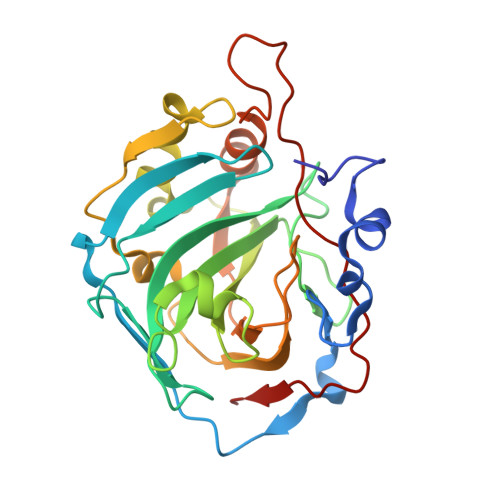Structural Analysis of Charge Discrimination in the Binding of Inhibitors to Human Carbonic Anhydrases I and II.
Srivastava, D.K., Jude, K.M., Banerjee, A.L., Haldar, M., Manokaran, S., Kooren, J., Mallik, S., Christianson, D.W.(2007) J Am Chem Soc 129: 5528-5537
- PubMed: 17407288
- DOI: https://doi.org/10.1021/ja068359w
- Primary Citation of Related Structures:
2NMX, 2NN1, 2NN7, 2NNG, 2NNO, 2NNS, 2NNV - PubMed Abstract:
Despite the similarity in the active site pockets of carbonic anhydrase (CA) isozymes I and II, the binding affinities of benzenesulfonamide inhibitors are invariably higher with CA II as compared to CA I. To explore the structural basis of this molecular recognition phenomenon, we have designed and synthesized simple benzenesulfonamide inhibitors substituted at the para position with positively charged, negatively charged, and neutral functional groups, and we have determined the affinities and X-ray crystal structures of their enzyme complexes. The para-substituents are designed to bind in the midsection of the 15 A deep active site cleft, where interactions with enzyme residues and solvent molecules are possible. We find that a para-substituted positively charged amino group is more poorly tolerated in the active site of CA I compared with CA II. In contrast, a para-substituted negatively charged carboxylate substituent is tolerated equally well in the active sites of both CA isozymes. Notably, enzyme-inhibitor affinity increases upon neutralization of inhibitor charged groups by amidation or esterification. These results inform the design of short molecular linkers connecting the benzenesulfonamide group and a para-substituted tail group in "two-prong" CA inhibitors: an optimal linker segment will be electronically neutral, yet capable of engaging in at least some hydrogen bond interactions with protein residues and/or solvent. Microcalorimetric data reveal that inhibitor binding to CA I is enthalpically less favorable and entropically more favorable than inhibitor binding to CA II. This contrasting behavior may arise in part from differences in active site desolvation and the conformational entropy of inhibitor binding to each isozyme active site.
Organizational Affiliation:
Department of Chemistry and Molecular Biology, North Dakota State University, Fargo, North Dakota 58105, USA. dk.srivastava@ndsu.nodak.edu

















